Build a Udemy Clone with Strapi and Next.js (Part 3)
— Strapi, Next.js — 11 min read
Introduction
In previous part we implemented user authentication, manage courses page & user progress.
In this final part of the series, we will learn how to implement rating system, cart feature & payment with Stripe.
Building cart feature
Go to the Content-Type builder and then click on "Create new collection type"
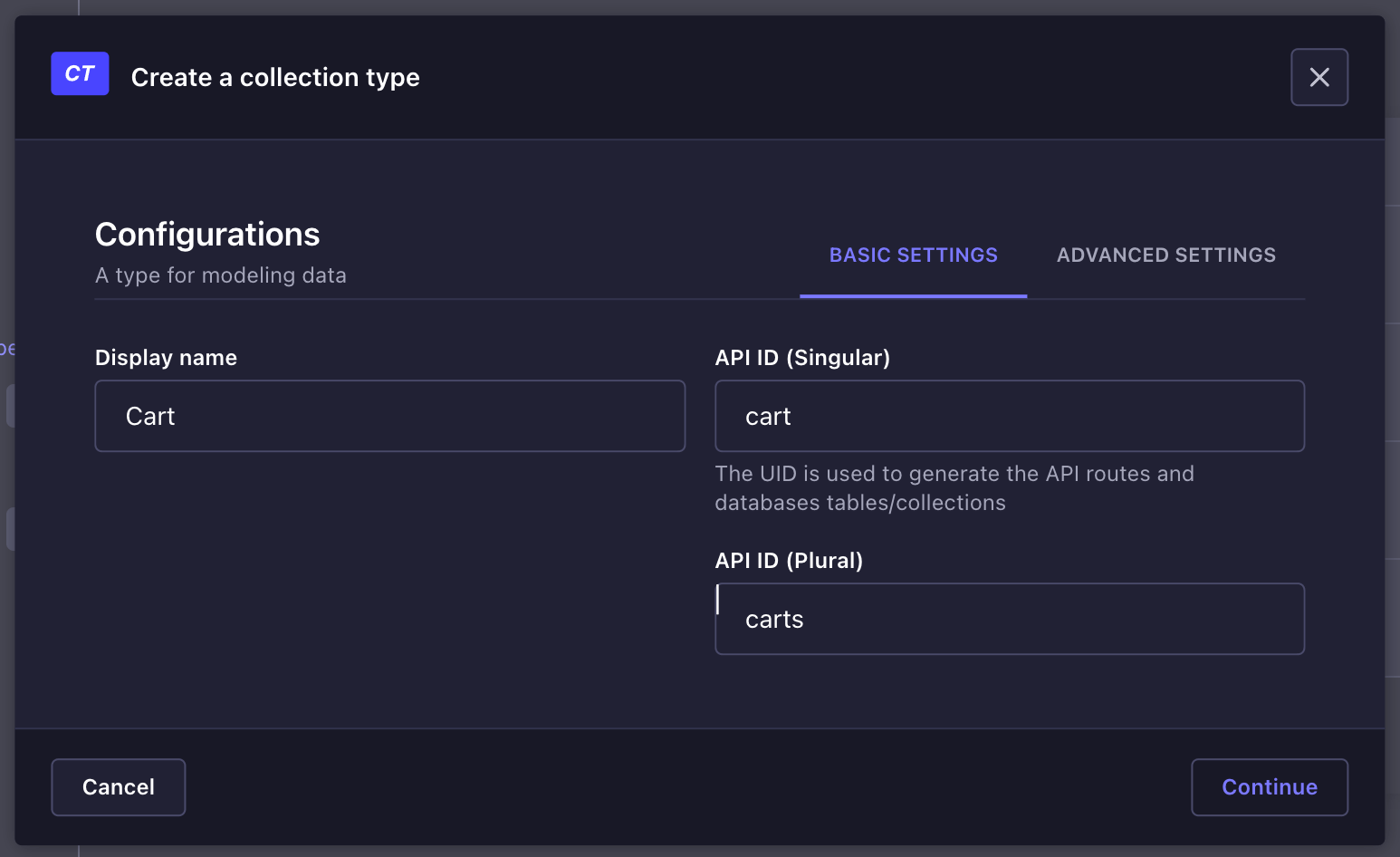
Then add these fields user: Relation - Cart has one user (Userfrom user permission plugin) courses: Relation - Cart has many Courses
Then let's create a context to hold the cart data.
Now we need to configure the permissions for the Authenticated user in Users & permissions plugin => Roles.
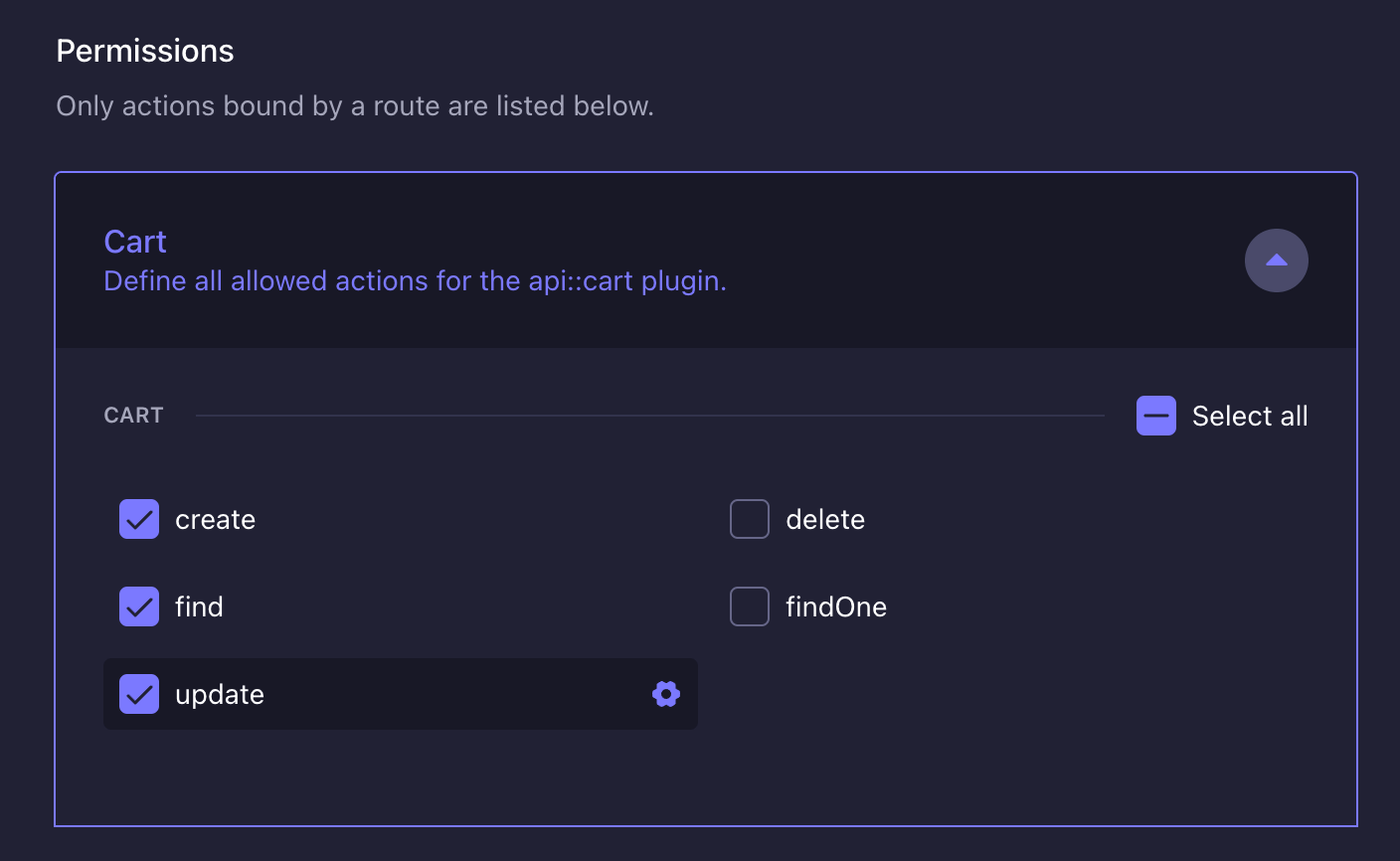
To be able to easily access & modify the cart we need to create hooks & utility function
frontend/hooks/useCart.js
import { useEffect, useState } from "react";import axios from "axios";
export const useCart = () => { const [userCart, setUserCart] = useState([]); const [loading, setLoading] = useState(true);
const fetchUserCart = async () => { try { const token = localStorage.getItem("token"); const currentUser = JSON.parse(localStorage.getItem("user")); const config = { headers: { Authorization: `Bearer ${token}` }, }; const response = await axios.get( `http://localhost:1337/api/carts?filters[user][id][$eq]=${currentUser.id}&populate=courses`, config, );
const cartData = response.data.data; setUserCart(cartData[0]); } catch (error) { console.error("Error fetching user cart:", error); } finally { setLoading(false); } };
useEffect(() => { fetchUserCart(); }, []);
const removeFromCart = async (courseId, cartId) => { const token = localStorage.getItem("token"); const config = { headers: { Authorization: `Bearer ${token}` }, }; try { await axios.put( `http://localhost:1337/api/carts/${cartId}`, { data: { courses: { disconnect: [courseId], }, }, }, config, ); fetchUserCart(); } catch (error) { console.error("Error removing from cart:", error); } };
return { userCart, loading, removeFromCart, fetchUserCart };};
export const addToCart = async (cart, course, toast) => { const token = localStorage.getItem("token"); const currentUser = JSON.parse(localStorage.getItem("user")); const config = { headers: { Authorization: `Bearer ${token}` }, };
if (cart?.length === 0 || !cart) { try { await axios.post( `http://localhost:1337/api/carts`, { data: { user: { connect: [currentUser.documentId], }, courses: { connect: [course.documentId], }, }, }, config, ); toast({ title: "Success", description: "Course added to cart", duration: 3000, variant: "success", }); } catch (error) { console.error("Error adding to cart:", error); } } else { try { const response = await axios.put( `http://localhost:1337/api/carts/${cart.documentId}`, { data: { courses: { connect: [course.documentId], }, }, }, config, ); toast({ title: "Success", description: "Course added to cart", duration: 3000, variant: "success", }); } catch (error) { console.error("Error adding to cart:", error); } }};In the code above we defines a custom React hook, useCart, which manages a user's shopping cart by fetching, adding, and removing courses.
Additionally, the addToCart function is defined to handle adding courses to the cart, providing user feedback through a toast notification upon success.
We need to create a component for adding course to cart from the course overview page in frontend/app/course/[slug]/page.js
Let's name it Sidebar
frontend/components/Sidebar.jsx
"use client";import { Button } from "@/components/ui/button";import { Card, CardHeader, CardTitle, CardContent } from "@/components/ui/card";import { useCart, addToCart } from "@/hooks/useCart";import Link from "next/link";import { useToast } from "@/hooks/use-toast";
const Sidebar = ({ course }) => { const { toast } = useToast(); const { userCart, fetchUserCart } = useCart();
const handleAddToCart = async () => { await addToCart(userCart, course, toast); await fetchUserCart(); };
return ( <Card className="w-96 border p-6"> <img src={course.thumbnail} alt="course thumbnail" /> <CardHeader> <CardTitle> <span className="text-2xl font-bold">{`$${course.price}`}</span> </CardTitle> </CardHeader> <CardContent> {currentUser && userCart?.courses?.filter((item) => item.id === course.id).length > 0 ? ( <Link href="/cart"> <Button className="w-full bg-blue-500 text-white"> Go to cart </Button> </Link> ) : currentUser && ( <Button className="w-full bg-blue-500 text-white" onClick={handleAddToCart} > Add to cart </Button> )} </CardContent> </Card> );};
export default Sidebar;In this component we call the useCart hooks and then display add to cart button if course is not already in the cart, if it's already in the cart we display a link to the cart page.
After that modify frontend/app/course/[slug]/page.js to display <Sidebar course={course} />
Now Course overview page will look like this.
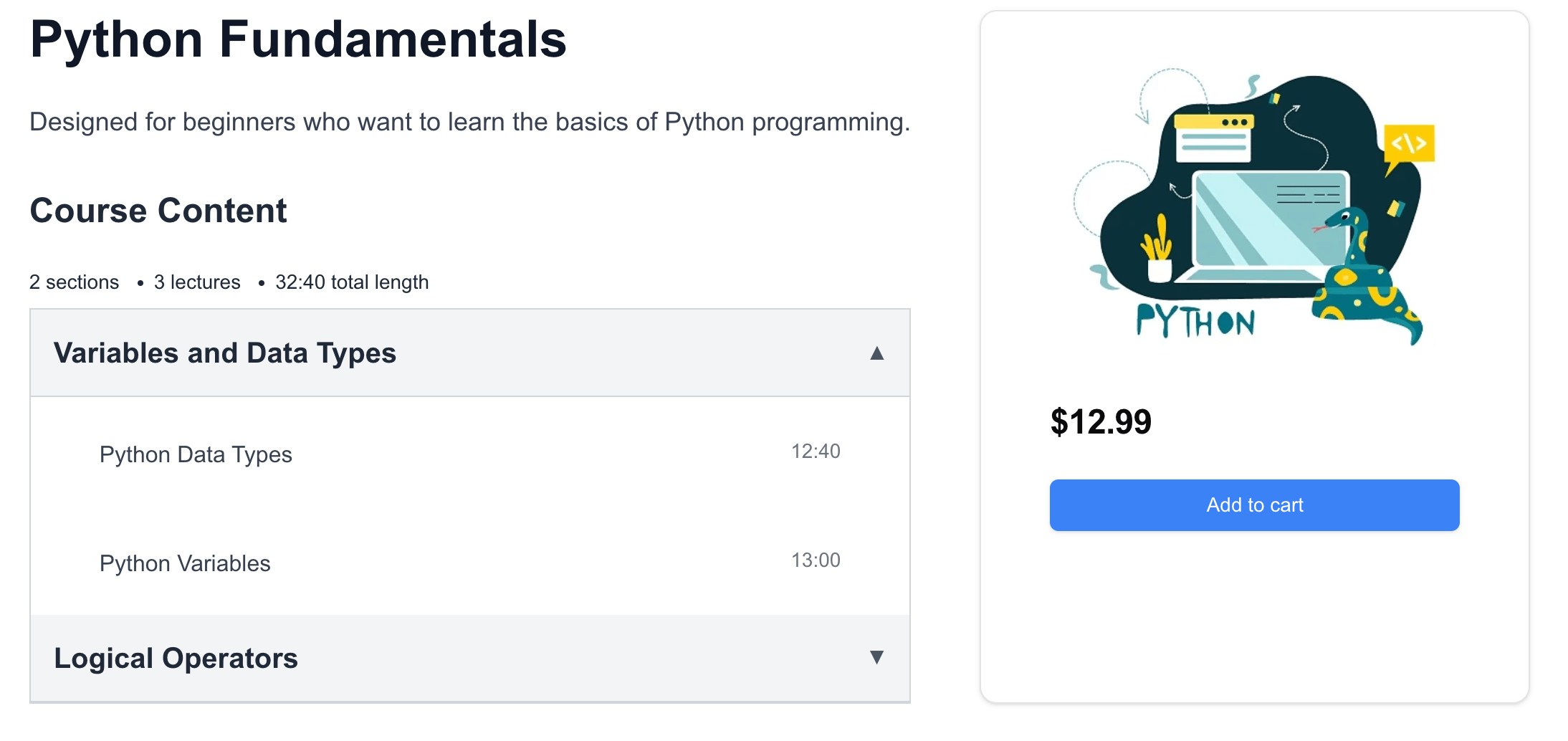
Lastly, we need to create cart page.
frontend/app/cart/page.jsx
"use client";import Navbar from "@/components/Navbar";import { Card, CardContent, CardHeader, CardFooter,} from "@/components/ui/card";import { Button } from "@/components/ui/button";import { Check, Delete } from "lucide-react";import Loader from "@/components/Loader";import { useCart } from "@/hooks/useCart";
const CartPage = () => { const { userCart, loading, removeFromCart } = useCart();
const handleRemoveFromCart = (courseId, cartId) => { removeFromCart(courseId, cartId); };
if (loading) return <Loader />;
return ( <div className="min-h-screen bg-gray-100 pt-4 px-24"> <Navbar /> <main className="container mx-auto px-4 py-8"> <div className="flex gap-12"> <div className="flex-1"> <h1 className="text-3xl font-semibold mb-6">Shopping Cart</h1> {userCart?.courses?.length === 0 || !userCart?.courses ? ( <p className="text-center text-gray-500">Your cart is empty</p> ) : ( <div className="space-y-4"> {userCart.courses.map((item) => { return ( <Card key={item.id} className="bg-white shadow-md rounded-md max-w-2xl" > <CardContent className="flex gap-4 pt-6"> <img className='w-24' src={item.thumbnail} alt="course thumbnail" /> <div> <h2 className="text-lg font-semibold">{item.title}</h2> <p className="font-bold text-xl">${item.price}</p> </div> {/* Add any additional item details here */} </CardContent> <CardFooter className="flex justify-end"> <Button variant="outline" color="red" onClick={() => handleRemoveFromCart( item.documentId, userCart.documentId, ) } className="flex items-center space-x-2" > <Delete className="w-5 h-5" /> <span>Remove</span> </Button> </CardFooter> </Card> ); })} </div> )} </div> </div> </main> </div> );};
export default CartPage;Now we have the full flow for cart feature.
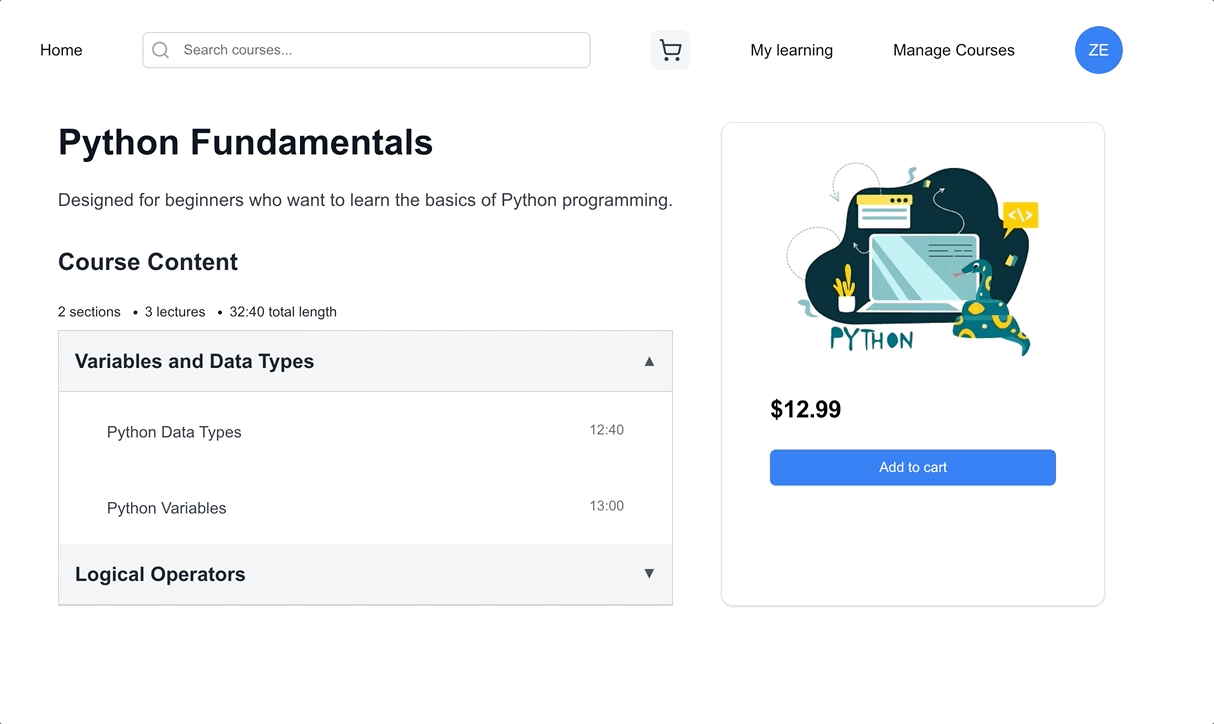
Implementing checkout & payment with Stripe
You will need to sign up for a stripe account to implement this feature.
If you already have an account, then configure this ENV variables in frontend
.env.local
NEXT_PUBLIC_STRIPE_PUBLIC_KEY=YOUR_PUBLIC_KEYSTRIPE_SECRET_KEY=YOUR_SECRET_KEYNEXT_PUBLIC_URL=http://localhost:3000Get publishable key from this page
https://dashboard.stripe.com/test/apikeys
Install Stripe SDK
npm install @stripe/stripe-js stripeAnd then create API endpoint to pass cart data to Stripe.
frontend/app/api/checkout/route.js
import { NextResponse } from "next/server";import Stripe from "stripe";
const stripe = new Stripe(process.env.STRIPE_SECRET_KEY, { apiVersion: "2022-11-15",});
export async function POST(request) { const { items, token,cartId } = await request.json();
const courseIds = items.map((item) => item.courseId);
const session = await stripe.checkout.sessions.create({ payment_method_types: ["card"], line_items: items.map((item) => ({ price_data: { currency: "usd", product_data: { name: item.name, }, unit_amount: item.price * 100, }, quantity: item.quantity, })), payment_intent_data: { metadata: { courseIds: JSON.stringify(courseIds), token: token, cartId: cartId }, }, expand: ["line_items"], mode: "payment", success_url: `${process.env.NEXT_PUBLIC_URL}/success`, cancel_url: `${process.env.NEXT_PUBLIC_URL}/cancel`, });
return NextResponse.json({ id: session.id });}In the code above we are passing back the courseId's, user token & cartId to our webhook if the payment is succesful.
Next, we need to create this webhook to detect if payment is succesful.
frontend/app/api/stripe_webhooks/route.js
import { NextResponse } from "next/server";import axios from "axios";
export async function POST(request) { try { const body = await request.json();
if (body.type === "payment_intent.succeeded") { const metadata = body.data.object.metadata; const courseIds = JSON.parse(metadata.courseIds); const token = metadata.token; const cartId = metadata.cartId;
const config = { headers: { Authorization: `Bearer ${token}` }, }; try { const res = await axios.put( `http://127.0.0.1:1337/api/carts/${cartId}`, { data: { courses: { disconnect: [...courseIds], }, }, }, config, ); console.log(res.status, res.statusText, "res"); } catch (error) { console.error("Error removing from cart:", error); }
try { const updateCoursePromises = courseIds.map((courseId) => axios.put( `http://127.0.0.1:1337/api/courses/${courseId}`, { data: { isPurchased: true, }, }, config, ), );
const responses = await Promise.all(updateCoursePromises); } catch (error) { console.error("Error updating courses:", error); } }
return NextResponse.json({ success: true }); } catch (error) { console.error("Error parsing request body:", error); return NextResponse.json( { success: false, error: "Invalid request body" }, { status: 400 }, ); }}In the code above, when the payment is succesful we are doing 2 things:
- Removing the course from the user cart
- Updating isPurchased field to true
Additionally, we will create a page for user to get redirected to if they have succesful payment and when they cancelled the payment.
frontend/app/success/page.jsx
import Navbar from '@/components/Navbar';
const SuccessPage = () => ( <div className="min-h-screen bg-gray-100 p-4 text-center px-24"> <Navbar/> <h1 className="text-3xl font-semibold mb-6 mt-12">Payment Successful!</h1> <p>Thank you for your purchase.</p> </div>);
export default SuccessPage;
For the cancellation create this page
frontend/app/cancel/page.jsx
import Navbar from '@/components/Navbar';
const CancelPage = () => ( <div className="min-h-screen bg-gray-100 p-4 text-center px-24"> <Navbar /> <h1 className="text-3xl font-semibold mb-6 mt-12">Payment Cancelled</h1> <p>Your payment was cancelled. Please try again.</p> </div>);
export default CancelPage;;
Now for the checkout button
frontend/components/CheckoutCart.jsx
"use client";import React from "react";import { loadStripe } from "@stripe/stripe-js";import { useCart } from "@/hooks/useCart";import { Button } from "@/components/ui/button";
const stripePromise = loadStripe(process.env.NEXT_PUBLIC_STRIPE_PUBLIC_KEY);
const CheckoutCart = () => { const { userCart } = useCart();
const handleCheckout = async () => { const response = await fetch("/api/checkout", { method: "POST", headers: { "Content-Type": "application/json", }, body: JSON.stringify({ items: userCart.courses.map((item) => ({ name: item.title, quantity: 1, price: item.price, courseId: item.documentId, })), token: localStorage.getItem('token'), cartId: userCart.documentId }), });
const { id } = await response.json(); const stripe = await stripePromise; stripe.redirectToCheckout({ sessionId: id }); };
return ( <div className="min-h-screen bg-gray-100 p-4"> <h1 className="text-3xl font-semibold mb-6">Checkout</h1> <Button onClick={handleCheckout} className="bg-blue-500 text-white px-4 py-2 rounded-md" > Checkout with Stripe </Button> </div> );};
export default CheckoutCart;In the code above we are iterating through cart array which contains courses and pass it as line items to Stripe SDK.
And then in frontend/app/cart/page.jsx conditionally render the checkout button.
{userCart?.courses?.length > 0 && ( <CheckoutCart />)}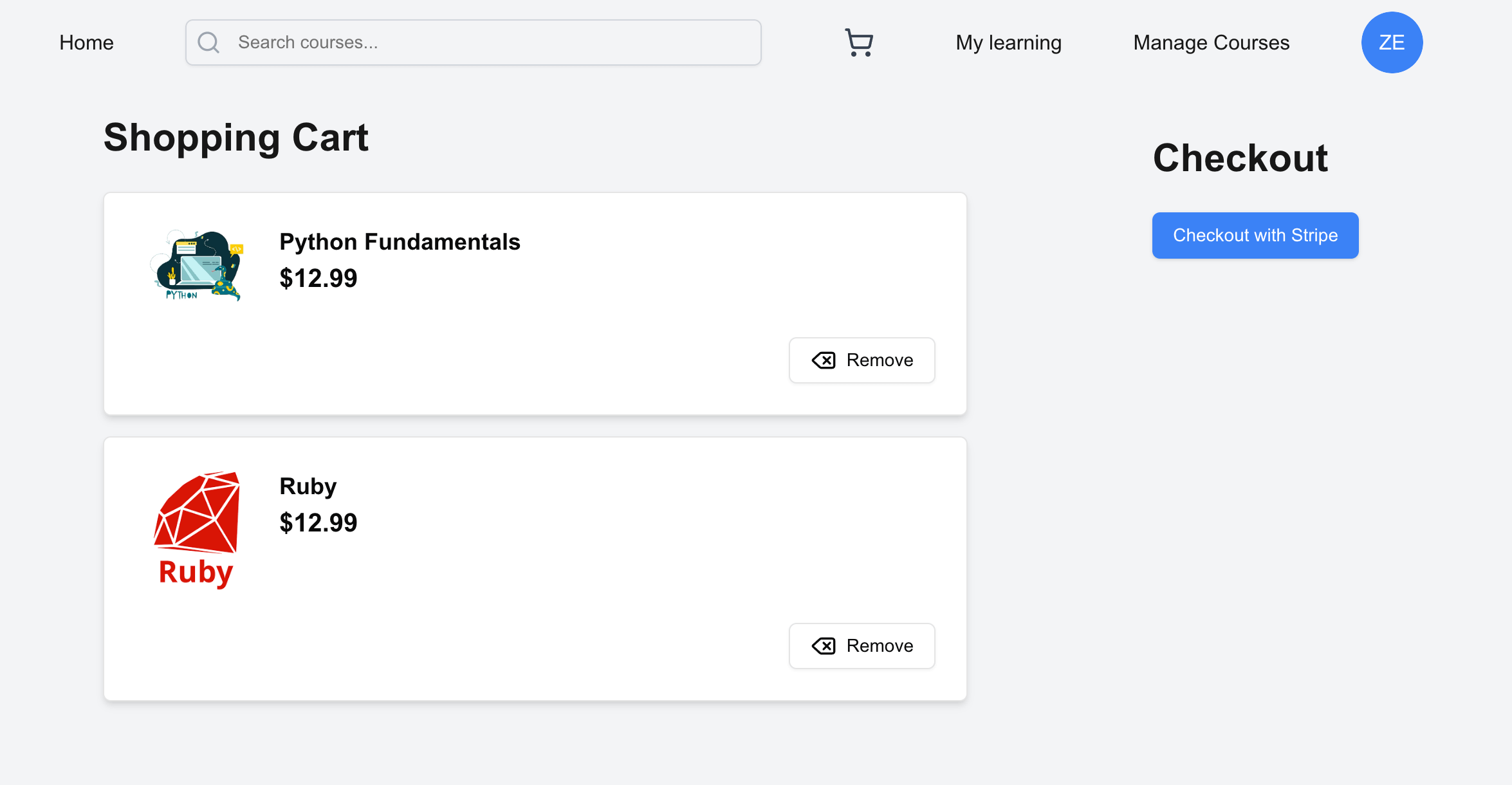
Lastly, let's modify the course frontend/app/my-learning/[courseSlug]/page.jsx to only allow user that already purchased to access the content.
import { useRouter } from "next/navigation";
const router = useRouter();// ... existing code// if (isLoading) return <Loader />;
if (!course.isPurchased) { router.push(`/`); }Testing the payment
Now to test it properly we will need Stripe CLI
In mac you can use brew install stripe/stripe-cli/stripe, you can find the equivalent command for windows here https://docs.stripe.com/stripe-cli
In the frontend run the following command
stripe listen --forward-to localhost:3000/api/stripe_webhooks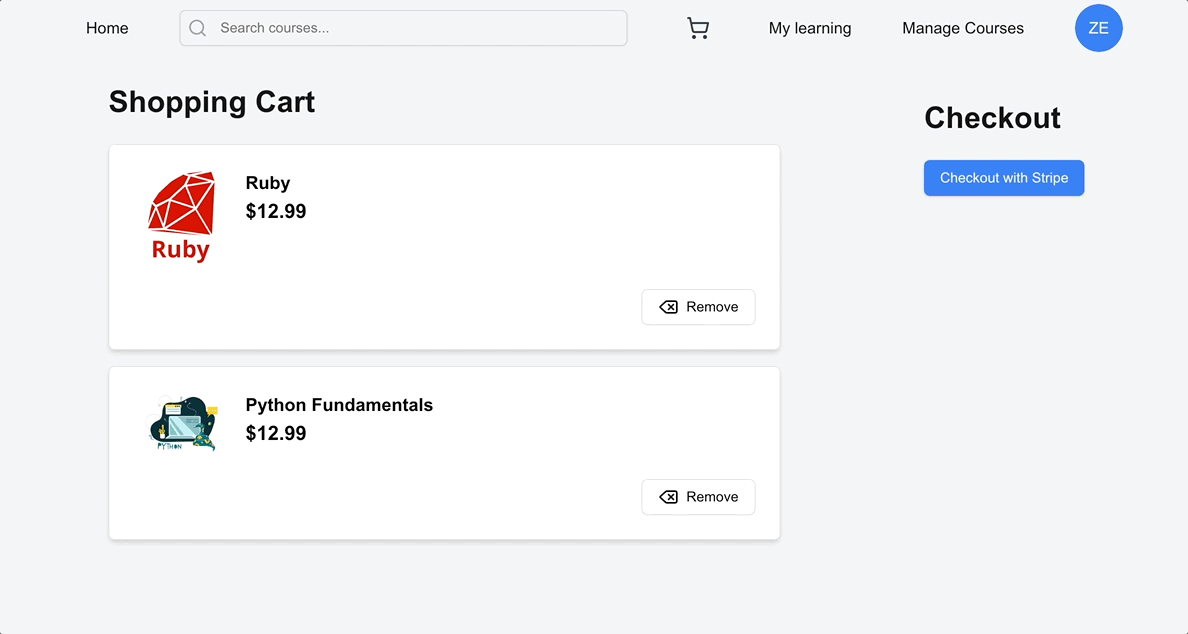
After succesful payment you will get redirected to this page

Implementing course rating system
Create Rating collection
Go to the Content-Type builder, and then create new collection type and name it "Rating".
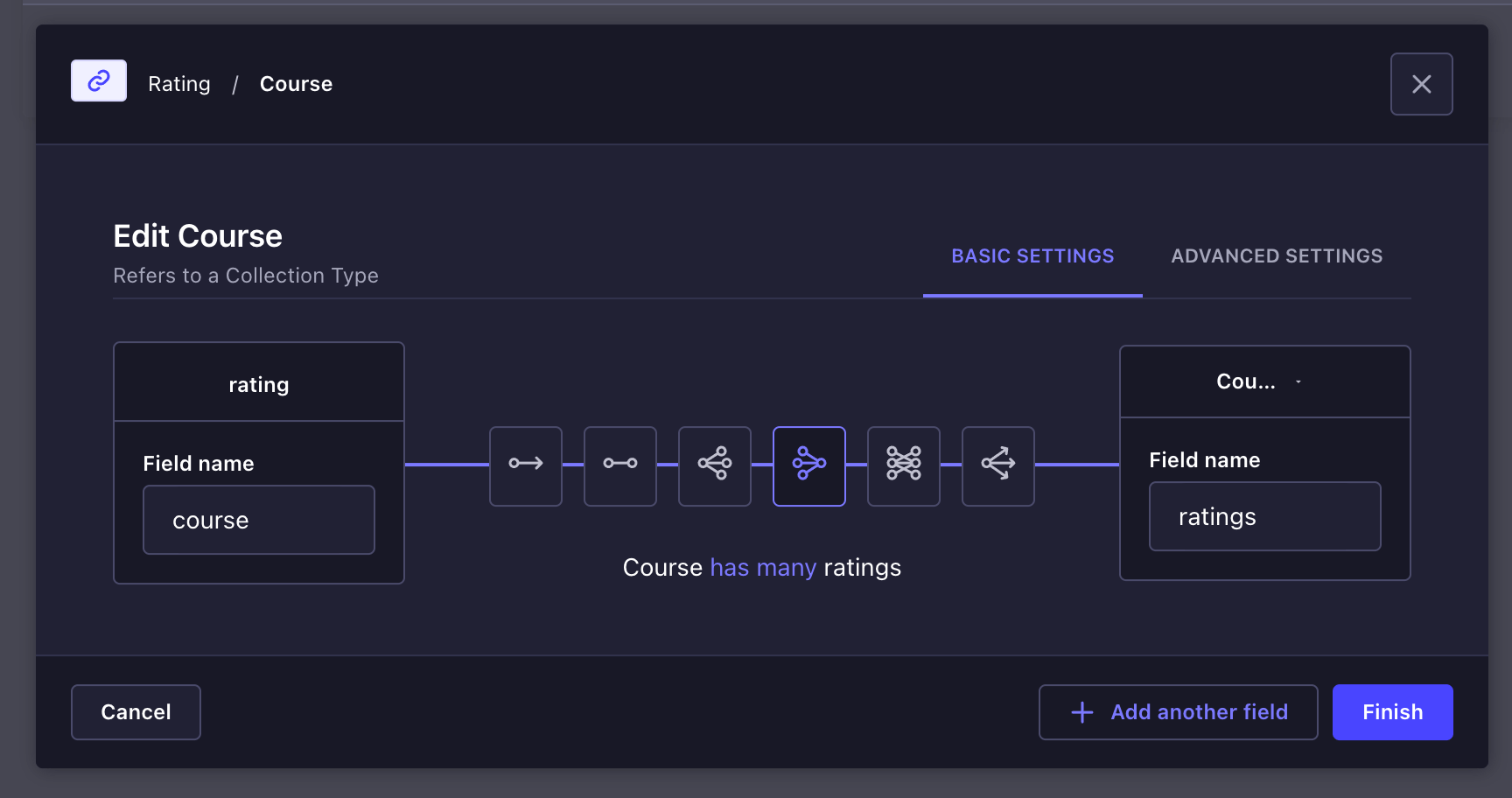
Then configure the following fields.
- Relation, Course has many ratings
- Relation, User has many ratings
- rating, number with type Integer
After that configure permissions for ratings
Go to Users & permission plugin => Roles => Authenticated
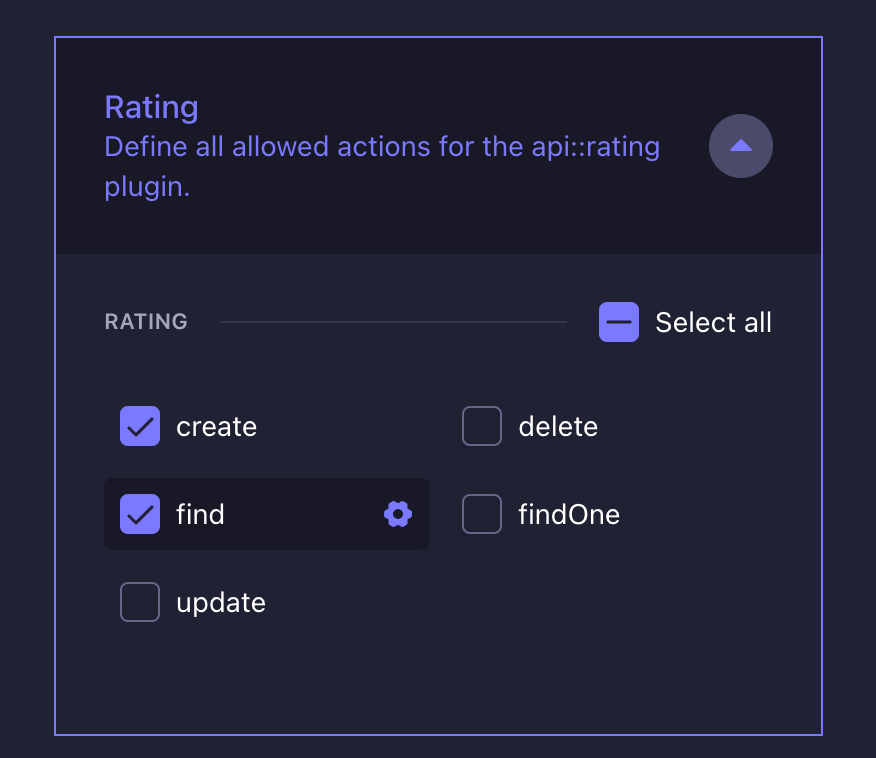
Now let's create the UI, In frontend run
npx shadcn@latest add dialogThen create this component frontend/components/CourseRatingDialog.jsx
import React, { useState } from "react";import { Dialog, DialogContent, DialogHeader, DialogTitle, DialogTrigger,} from "@/components/ui/dialog";import { Button } from "@/components/ui/button";import { Star } from "lucide-react";import axios from "axios";
const CourseRatingDialog = ({ selectedCourse, setSelectedCourse, setCourseProgresses, isAlreadyRated, fetchCourseProgresses,}) => { const [rating, setRating] = useState(0); const [tempRating, setTempRating] = useState(0); const [isOpen, setIsOpen] = useState(false);
const getRatingText = (rating) => { switch (rating) { case 1: return "Very Bad"; case 2: return "Bad"; case 3: return "Good"; case 4: return "Great"; case 5: return "Excellent"; default: return "Rate this course"; } };
const handleStarClick = (star) => { setRating(star); setTempRating(star); };
const handleOpen = () => { setIsOpen(true); setSelectedCourse(selectedCourse); };
const handleClose = () => { setIsOpen(false); setSelectedCourse(null); setRating(0); setTempRating(0); };
const handleRating = async () => { if (!selectedCourse || !rating) return;
try { const currentUser = localStorage.getItem("user"); const token = localStorage.getItem("token"); const currentUserId = JSON.parse(currentUser).documentId; const config = { headers: { Authorization: `Bearer ${token}` }, }; await axios.post( "http://localhost:1337/api/ratings", { data: { rating: rating, course: { connect: [selectedCourse.documentId], }, user: { connect: [currentUserId], }, }, }, config, ); setCourseProgresses((prevProgresses) => prevProgresses.map((progress) => progress.course.id === selectedCourse.id ? { ...progress, userRating: rating } : progress, ), ); fetchCourseProgresses(); setSelectedCourse(null); setRating(0); setTempRating(0); handleClose(); } catch (error) { console.error("Error saving rating:", error); } };
return ( <Dialog open={isOpen} onOpenChange={setIsOpen}> <DialogTrigger asChild> <div onClick={handleOpen} className="cursor-pointer"> <div className="flex gap-1"> {[1, 2, 3, 4, 5].map((star) => ( <Star key={star} className={`h-4 w-4 cursor-pointer ${ star <= (isAlreadyRated?.rating || 0) ? "text-yellow-400 fill-yellow-400" : "text-gray-300" }`} /> ))} </div> {isAlreadyRated ? ( <p className="text-sm mt-1">Your rating</p> ) : ( <p className="text-sm mt-1">Leave a rating</p> )} </div> </DialogTrigger> <DialogContent> <DialogHeader> <DialogTitle>Rate this course</DialogTitle> </DialogHeader> <div className="flex flex-col items-center"> <h2 className="text-xl mb-4">{selectedCourse?.title}</h2> <div className="flex flex-col items-center mb-4"> <div className="flex mb-2"> {[1, 2, 3, 4, 5].map((star) => ( <Star key={star} className={`h-8 w-8 cursor-pointer ${ star <= (tempRating || rating || 0) ? "text-yellow-400 fill-yellow-400" : "text-gray-300" }`} onClick={() => handleStarClick(star)} onMouseEnter={() => setTempRating(star)} onMouseLeave={() => setTempRating(rating)} /> ))} </div> <span className="text-sm">{getRatingText(tempRating)}</span> </div> <Button className="px-4 py-2" onClick={handleRating}> Submit Rating </Button> </div> </DialogContent> </Dialog> );};
export default CourseRatingDialog;The CourseRatingDialog component will allow users to rate a course through a star-based interface within a dialog.
And then modify frontend/app/my-learning/page.jsx
import CourseRatingDialog from "@/components/CourseRatingDialog";
const [selectedCourse, setSelectedCourse] = useState(null); const currentUser = JSON.parse(localStorage.getItem("user"));
const fetchCourseProgresses = async () => { try { const token = localStorage.getItem("token");
const config = { headers: { Authorization: `Bearer ${token}` }, }; const response = await axios.get( `http://127.0.0.1:1337/api/course-progresses?filters[user][id][$eq]=${currentUser.id}&[populate][course][populate][ratings][populate]=user`, config, ); setCourseProgresses(response.data.data); setIsLoading(false); } catch (error) { console.error("Error fetching course progresses:", error); setIsLoading(false); } };
useEffect(() => { fetchCourseProgresses(); }, []);// ...rest of code<div className="flex justify-between items-center mt-4"> <Link href={`/my-learning/${progress.course.slug}`} className="inline-block bg-blue-500 text-white px-4 py-2 rounded hover:bg-blue-600" > Continue Learning </Link> <CourseRatingDialog isAlreadyRated={progress.course.ratings.find( (rating) => rating.user.id === currentUser.id, )} selectedCourse={progress.course} setSelectedCourse={setSelectedCourse} setCourseProgresses={setCourseProgresses} fetchCourseProgresses={fetchCourseProgresses} /> </div>// ...rest of codeThis is the result
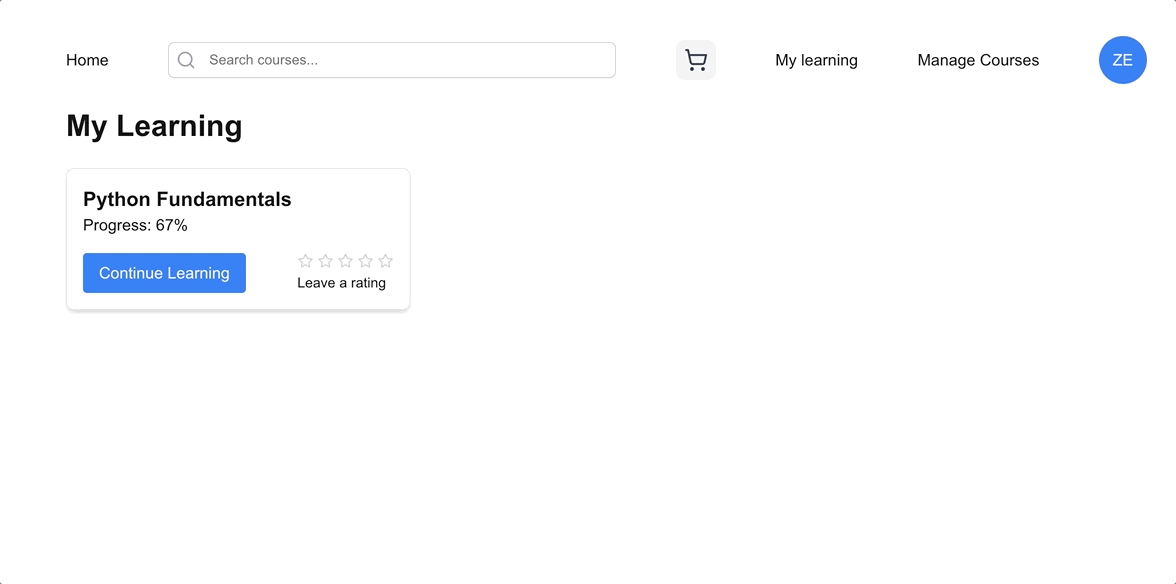
Conclusion
In the this final part of the article series, we've learned how to implement rating system, cart feature & payment with Stripe.
You can find the full code in https://github.com/ZehaIrawan/strapi-udemy-clone